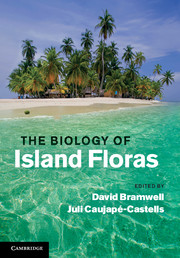Book contents
- Frontmatter
- Contents
- Contributors
- Preface
- 1 Introduction: islands and plants
- 2 The reproductive biology of island plants
- 3 Spatial methodologies in historical biogeography of islands
- 4 Origin and evolution of Hawaiian endemics: new patterns revealed by molecular phylogenetic studies
- 5 Origins and evolution of Galapagos endemic vascular plants
- 6 The plants of the Caribbean islands: a review of the biogeography, diversity and conservation of a storm-battered biodiversity hotspot
- 7 The biogeography of Madagascar palms
- 8 Evolution and biogeography of the flora of the Socotra archipelago (Yemen)
- 9 Biogeography and conservation of the flora of New Caledonia
- 10 Phytogeography and relationships of the Pitcairn Islands flora
- 11 Chromosomes and evolution in New Zealand endemic angiosperms and gymnosperms
- 12 Jesters, red queens, boomerangs and surfers: a molecular outlook on the diversity of the Canarian endemic flora
- 13 Endemism and evolution in Macaronesian and Mediterranean Limonium taxa
- 14 Dispersal, diversity and evolution of the Macaronesian cryptogamic floras
- 15 Invasive alien species and islands
- 16 Ecology, demography and conservation in the Galapagos Islands flora
- 17 New directions and challenges for the conservation of the flora of Madagascar
- 18 Climate change and island floras
- 19 Conservation status of endemic plants on Isla del Coco, Costa Rica: applying IUCN Red List criteria on a small island
- 20 Botanic gardens and the conservation of island floras
- 21 The hazardous future of island floras
- Index
- References
2 - The reproductive biology of island plants
Published online by Cambridge University Press: 07 October 2011
- Frontmatter
- Contents
- Contributors
- Preface
- 1 Introduction: islands and plants
- 2 The reproductive biology of island plants
- 3 Spatial methodologies in historical biogeography of islands
- 4 Origin and evolution of Hawaiian endemics: new patterns revealed by molecular phylogenetic studies
- 5 Origins and evolution of Galapagos endemic vascular plants
- 6 The plants of the Caribbean islands: a review of the biogeography, diversity and conservation of a storm-battered biodiversity hotspot
- 7 The biogeography of Madagascar palms
- 8 Evolution and biogeography of the flora of the Socotra archipelago (Yemen)
- 9 Biogeography and conservation of the flora of New Caledonia
- 10 Phytogeography and relationships of the Pitcairn Islands flora
- 11 Chromosomes and evolution in New Zealand endemic angiosperms and gymnosperms
- 12 Jesters, red queens, boomerangs and surfers: a molecular outlook on the diversity of the Canarian endemic flora
- 13 Endemism and evolution in Macaronesian and Mediterranean Limonium taxa
- 14 Dispersal, diversity and evolution of the Macaronesian cryptogamic floras
- 15 Invasive alien species and islands
- 16 Ecology, demography and conservation in the Galapagos Islands flora
- 17 New directions and challenges for the conservation of the flora of Madagascar
- 18 Climate change and island floras
- 19 Conservation status of endemic plants on Isla del Coco, Costa Rica: applying IUCN Red List criteria on a small island
- 20 Botanic gardens and the conservation of island floras
- 21 The hazardous future of island floras
- Index
- References
Summary
Since the review of the reproductive biology of island plants by Ehrendorfer (1979) three decades ago, there has been a veritable explosion of studies on plants of oceanic islands. Although the primary emphasis, particularly in the past two decades, has been on molecular phylogenetics of island lineages (Baldwin et al., 1998; Emerson, 2002), there also has been progress in understanding their reproductive biology. However, the comment by Ehrendorfer (1979: 293) about reproductive biology of island plants still applies today: ‘This is an extensive, fascinating, and complex field of inquiry, still insufficiently covered by relevant work and factual evidence.’ And, of course, there is the exhortation by Herbert Baker from his classic paper in Evolution from 1967: ‘Clearly, the greatest need in this area of biology is for further field and experimental studies (by as many workers as can spare their time) on the reproductive biology of the plants which make up floras of all kinds.’
- Type
- Chapter
- Information
- The Biology of Island Floras , pp. 11 - 36Publisher: Cambridge University PressPrint publication year: 2011
References
- 24
- Cited by



